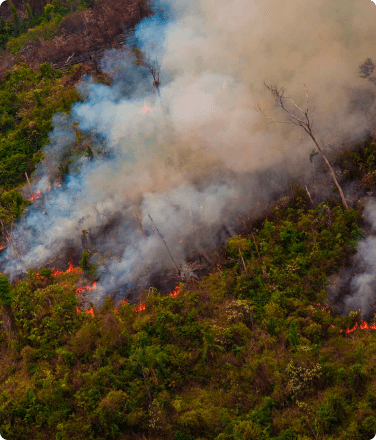The newest Rights Resources Initiative (RRI ) study, Cornered By Protected Areas, documents how fortress conservation is “hurting people and forests alike.” Researchers from around the world, including Rainforest Foundation US’s Christine Halvorson document how public policy and environmental organizations are instituting fortress conservation. This kind of environmental protection is not only violates human and land rights, it is out of step with the most effective and research-based solutions for protecting our forests.
National parks can save forests — Or contribute to their disappearance
A new national park is created in a highly biodiverse rainforest. It sounds like a victory, right?
Too often these parks are created from the ancestral lands of indigenous people. Abruptly, these communities are forced to adapt to new rules about what they can and cannot do in their forests. On occasion, they are forcibly removed from these areas. This practice is known as fortress conservation, and it happens the world over.
Indigenous Communities’ Track Record – Second to None
Parks are created in order to preserve highly biodiverse areas. Yet, ironically, it is often the indigenous communities that safeguard this biodiversity year after year. It is no coincidence that 80% of our planet’s remaining biodiversity is on indigenous lands. This is important, now more than ever, because we are destroying life on our planet at an alarming rate: to date, humans have caused the global loss of 83% of all wild mammals and half of all plant life.
Fortress Conservation Ignores Evidence and Science
Fortress conservation imagines forests as naturally free of humans, and in doing so does not recognize that humans are a part of nature. It also disregards that the efforts of indigenous communities are the reason much of our forests remain.
Those who push for fortress conservation believe that creating protected areas where ecosystems function without human interference is the best way to protect the forest. This kind of conservation blames indigenous communities for using natural resources in these environmentally significant areas — refusing to recognize that it is these very communities that have preserved the biodiverse forests the conservationists aim to protect.
Fortress conservation is indigenous exclusive. It enlists park rangers and other government agents to patrol the boundaries of the parks to keep indigenous peoples from returning to their land.
At the same time, fortress conservation often promotes use of the forest by the tourist and safari hunting industries, and opens it up to scientific research. These (often exploitative) behaviors are seen as preferable to allowing the indigenous peoples to remain in their traditional homes.
A Human Rights, Climate, and Biodiversity Crisis
Not surprisingly, as indigenous communities find themselves excluded from their ancestral lands, they come into conflict with government agents tasked with maintaining the park. The RRI study highlights the price indigenous communities are paying as fortress conservation is instituted around the world.
“When bulldozers or park rangers force indigenous peoples from their homes, it is not only a human rights crisis—it is also a detriment to all humanity. Indigenous peoples have long stewarded and protected the world’s forests, a crucial bulwark against climate change.”
– Victoria Tauli-Corpuz, UN Special Rapporteur on the Rights of Indigenous Peoples
Yet fortress conservation isn’t the only option, even when designating protected areas and national parks. When indigenous communities are included in conservation planning and decision making and when their land rights are respected, protected areas become powerful ways to protect rainforests. Rainforest Foundation US’s work with the two communities of Nuevo Saposoa and Patria Nueva in Peru demonstrated just how effective partnerships between indigenous communities and government agencies are in safeguarding protected areas. Indigenous communities have already demonstrated that they are more than allies in the fight to protect our remaining forests they are the leaders.
“Worldwide, community lands hold at least a quarter of above ground tropical forest carbon—equal to four times global greenhouse gas emissions for 2014—and likely much more.”
– Victoria Tauli-Corpuz
In Panama Protected Areas Become an Excuse to Reject Land Rights
In Panama, indigenous communities are engaged in a centuries-old fight for the rights to their land. In some cases, specific requests for official recognition of land titles have been pending for more than 50 years. During this time one thing has remained constant: the lands that indigenous communities inhabit are consistently healthier than other lands. Indeed almost all of Panama’s remaining forest is on indigenous land. Panama’s Darien rainforest has been recognized as a UNESCO World Heritage Site because of its biodiversity. Ironically the designation as a UNESCO site is being used as justification for removing the very groups responsible for its survival.
At the moment, the Ministry of Environment has held up titling for over two years, with more than two-thirds of current indigenous land claims pending due to overlaps. The situation has become a major bottleneck in the recognition of indigenous land rights in Panama.
Designated as national parks or protected areas, these forests are ostensibly in safe hands. However, fortress conservation sees land invasions and illegal logging at rates that are higher than indigenous forests.
This problem is not confined to the Darien; throughout Panama, national parks and protected areas are used to delay or deny recognition of land titles. The communities’ demand for the legal recognition of their land rights are consistently met with stalling tactics.
“The Ministry of Environment has blocked titling in areas apparently covered by the park extension. In meetings, the Ministry has alleged that titling in the park or in the proposed extensions would compromise the park’s status as a UNESCO biosphere reserve. Clarification on this from UNESCO has been requested but has not yet been forthcoming.”
– Christine Halvorson
Beyond Panama and Peru
Learn more about fortress conservation and its effect on indigenous and rainforests around the world. Check out RRI’s map and explore how the practice is being used around the world to strip communities of their rights and putting our biodiversity and climate at risk.







